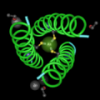We've had a good time in the past few last weeks, identifying unknown sequences and learning our way around a GenBank nucleotide record. To some people, it seems that this is all there is to doing digital biology. They would, of course, be wrong.
We can do much, much more than identifying DNA sequences and obtaining crucial information, like who left their DNA behind on that little blue dress.
Today, we're going to a deeper question about who we are and who are our relatives.
Drumroll, okay, here it comes:
How similar are DNA sequences between humans and apes?
Your assignment is to find out.
We'll do this on a small scale to make this a quicker experiment. For now, we will just compare a genome sequence from human mitochondria with whatever mitochondrial sequences, we can find, from different kinds of apes.--evolution!-->
Here are your instructions:
1. Go to the blastn page at the NCBI.
Use a new browser window, so you can keep the instructions here in front of you. If you haven't done this before, open up the File menu and choose New Window or the equivalent.
2. Type: NC_001807 in the large empty box. This is an accession number for the complete sequence of a human mitchondrial genome.
3. Type:great apes
in the "Limit by entrez query" box as shown in the image below.

4. Click the BLAST button.
5. Click the Format button on the page that appears.
Here are the questions for you to think about:
What do the results mean?
And of course, can we answer our original question?
How similar are the DNA sequences between these creatures?
Is this pattern consistent throughout the entire mitochondrial genome?
Come back next Friday for more fun with digital biology, or if you want more immediate help, check out the tutorial section of Geospiza Education and look for the tutorial on Mitochondria and Chloroplasts as models for genomics.
Read ahead: moving mitochondrial DNA (horizontal gene transfer?), comparing apes and humans, building a tree
technorati tags: digital biology,
blast, bioinformatics, evolution, genetics
